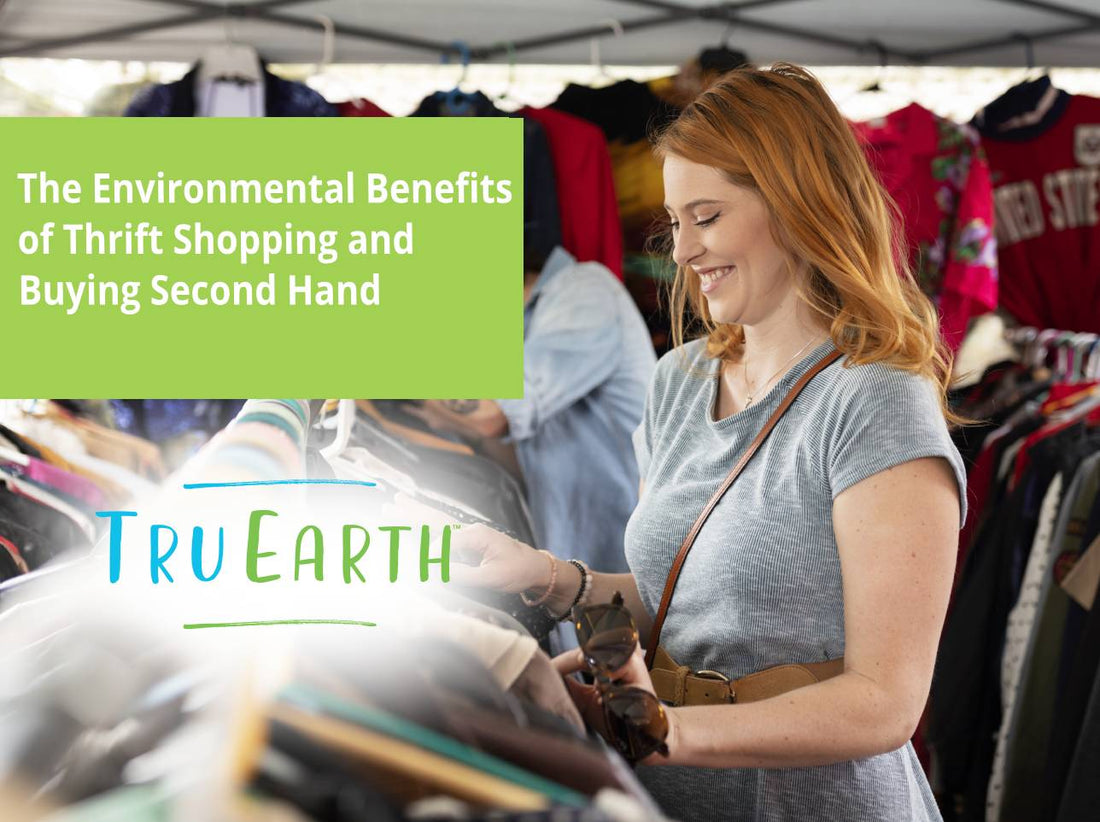In een wereld die steeds meer gericht is op duurzaamheid en milieubewustzijn, hebben kringloopwinkels en het kopen van tweedehands goederen aan populariteit gewonnen. Naast de sensatie van het vinden van unieke schatten, bieden deze praktijken aanzienlijke voordelen voor zowel de planeet als uw portemonnee.
In dit artikel gaan we dieper in op de milieuvriendelijke voordelen van tweedehands winkelen en laten we zien hoe deze bewuste benadering van consumptie bijdraagt aan het verminderen van afval, het behouden van hulpbronnen en het bevorderen van een groenere levensstijl.

De voetafdruk van de mode verkleinen: textielafval verminderen
De snelle omloopsnelheid van fast fashion draagt aanzienlijk bij aan de textielverspilling. Kringloopwinkels gaan deze trend tegen door de levensduur van kleding te verlengen en de vraag naar nieuwe kleding te verminderen.
Door te kiezen voor tweedehandskleding draag je direct bij aan de vermindering van textielafval dat op stortplaatsen of in verbrandingsovens belandt. Kringloopwinkels bieden een mogelijkheid om kleding te recyclen en zo de negatieve milieueffecten van de grondstofintensieve processen in de mode-industrie te verminderen.
Behoud van hulpbronnen: de levensduur van producten verlengen
Elk tweedehands gekocht item is een overwinning op de overmatige consumptie van eindige grondstoffen. Kringloopwinkelen verlengt de levensduur van producten en voorkomt de noodzaak voor nieuwe productie.
Dit vermindert op zijn beurt het verbruik van grondstoffen, energie en water dat nodig is voor de productie. Door gebruikte artikelen een nieuw leven te geven, neemt u deel aan een cyclus van hulpbronnenbesparing die zowel het milieu als toekomstige generaties ten goede komt.
Vermindering van de CO2-voetafdruk: minimalisering van transport en productie
De productie en het transport van nieuwe goederen genereren een aanzienlijke CO2-uitstoot. Kringloopwinkels verkleinen de CO2-voetafdruk die gepaard gaat met productie en verzending aanzienlijk.
Wanneer u kiest voor tweedehands artikelen, bespaart u niet alleen grondstoffen, maar minimaliseert u ook de uitstoot van broeikasgassen die gepaard gaat met de productie en het transport van nieuwe producten. Deze kleine verandering in uw winkelgedrag kan leiden tot een aanzienlijke vermindering van uw persoonlijke CO2-voetafdruk.
Ondersteuning van lokale economieën: versterking van gemeenschapsbanden
Kringloopwinkels hebben vaak een sterke band met de lokale gemeenschap. Wanneer je tweedehands spullen bij deze winkels koopt, draag je bij aan de lokale economie en steun je kleine bedrijven.
Deze financiële steun kan zich vertalen in verbeterde gemeenschapsmiddelen, meer werkgelegenheid en de groei van duurzame lokale economieën. Door kringloopwinkels te bezoeken, bevordert u een gemeenschapsgevoel en samenwerking die veel verder reikt dan uw aankoop.
Het bevorderen van ethische consumptie: een standpunt tegen uitbuitende praktijken
De mode- en consumentenindustrie krijgen kritiek op hun onethische arbeidspraktijken. Door te kiezen voor tweedehands winkelen in plaats van fast fashion, geef je een duidelijk signaal af tegen uitbuitende arbeidsomstandigheden en promoot je ethische consumptie.
Tweedehandsartikelen worden niet geassocieerd met dezelfde uitbuitende toeleveringsketens als nieuwe producten. Uw aankoop is een uiting van steun voor een eerlijke behandeling van werknemers wereldwijd.
Bewust consumeren omarmen: de vraag naar nieuwe goederen verminderen
Een van de meest impactvolle voordelen van kringloopwinkelen is de rol die het speelt bij het beteugelen van de onophoudelijke vraag naar nieuwe goederen. In een consumptiegedreven cultuur zorgt de aankoop van gloednieuwe artikelen ervoor dat er voortdurend geproduceerd moet worden, wat leidt tot uitputting van hulpbronnen en belasting van het milieu.
Kringloopwinkelen doorbreekt deze cyclus door je koopkracht te kanaliseren naar bestaande artikelen, waardoor de noodzaak tot nieuwe productie afneemt. Deze aanpak geeft een duidelijk signaal aan industrieën en moedigt hen aan om duurzamere praktijken te implementeren en hun impact op het milieu te verminderen.
Een les in creativiteit en persoonlijke expressie
Kringloopwinkelen stimuleert creativiteit en persoonlijke expressie. Wanneer je door tweedehands artikelen snuffelt, kun je unieke stukken ontdekken die jouw individuele stijl weerspiegelen.
Het hergebruiken en upcyclen van spullen uit kringloopwinkels kan resulteren in unieke decoraties, kleding en accessoires die je persoonlijkheid benadrukken. Dit vermindert niet alleen de vraag naar nieuwe producten, maar voegt ook een persoonlijk tintje toe aan je levensstijl, waardoor je omgeving echt een afspiegeling wordt van je waarden en smaak.
Investeren in kwaliteit: tijdloze vondsten met karakter
Tweedehands shoppen biedt de kans om hoogwaardige artikelen te ontdekken die de tand des tijds hebben doorstaan. Veel kringloopartikelen stammen uit vroegere tijden, toen vakmanschap en duurzaamheid voorop stonden.
Door te kiezen voor tweedehands, verwerf je items met karakter en geschiedenis, vaak voor een fractie van de prijs van nieuwe exemplaren. Deze tijdloze vondsten dragen niet alleen bij aan je unieke stijl, maar bevorderen ook de duurzaamheid door de wegwerpcultuur die geassocieerd wordt met massaproducten te ontmoedigen.
Ondersteuning van non-profitorganisaties: winkelen met een doel
Kringloopwinkels opereren vaak als non-profitorganisaties, waarbij de opbrengst vaak naar goede doelen gaat. Uw kringloopwinkelactiviteiten dragen direct bij aan deze initiatieven, waardoor u met een doel kunt winkelen. Of het nu gaat om het steunen van lokale opvangcentra, educatieve programma's of humanitaire projecten, uw aankopen dragen bij aan een positieve impact die verder gaat dan uw persoonlijke gewin.

Jouw rol in een groenere toekomst
Kringloopwinkelen is meer dan alleen een trend; het is een bewuste keuze met verstrekkende gevolgen voor het milieu. Door kringloopwinkels en tweedehandswinkels te omarmen, draagt u actief bij aan het verminderen van afval, het behoud van hulpbronnen en het beperken van de milieu-impact.
Jouw acties dienen als inspiratie voor anderen en bevorderen een verschuiving naar een duurzamere en bewustere consumptieaanpak. In een wereld waar elke individuele keuze ertoe doet, draagt jouw beslissing om kringloopwinkels te omarmen aanzienlijk bij aan een groenere toekomst voor onze planeet.


